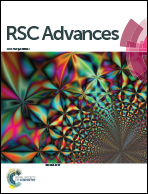Tunability of monodispersed intermetallic AuCu nanoparticles through understanding of reaction pathways†
Abstract
Synthesis of size selective monodispersed nanoparticles particularly intermetallic with well-defined compositions represents a challenge. This paper presents a way for the synthesis of intermetallic AuCu nanoparticles as a model system. We show that reduction of Au and Cu precursors is sensitive to the ratio of total molar concentrations of surfactant to metal precursors. A careful design of experiments to understand the kinetics of the reduction process reveals initial formation of seed nanoparticles of pure Au. Reduction of Cu occurs on the surface of the seed followed by diffusion to yield AuCu. This understanding allows us to develop a two step synthesis where the precise size controlled seed of Au nanoparticles produced in the first step is used in the second step reaction mixture as an Au precursor to allow deposition and interdiffusion of Cu that yields size selected AuCu intermetallics of sub 10 nm sizes.


 Please wait while we load your content...
Please wait while we load your content...